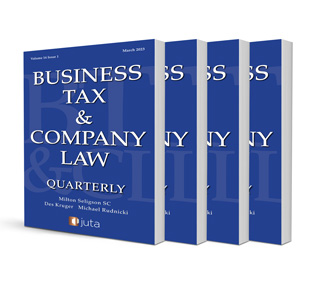
‘Dividend–stripping’ Complexities and the Interaction with the ‘Rollover’ Relief Provisions
Authors: Michael Rudnicki and Dean du Toit
ISSN: 2219-1585
Affiliations: Michael Rudnicki (Executive, Tax) and Dean du Toit (Senior Associate, Tax) — Bowmans
Source: Business Tax & Company Law Quarterly, Volume 14 Issue 4, 2023, p. 22 – 29
Abstract
The legislative rules relating to ‘dividend-stripping’ are complex and everevolving. This article seeks to examine the more complex aspects of those rules, particularly as they relate to the anti-avoidance elements of the legislation. The simplest way to explain the application of these rules is to illustrate their application with concrete examples. Prior to the application of the dividend-stripping rules it was relatively easy to escape tax on share exits, whereby a purchaser subscribed for shares in a target company and the target company repurchased the sellers’ shares free of tax by way of a ‘return of capital’ and/or a dividend distribution. The article deals with the rules as they apply in relation to (a) deferral transactions; and (b) ‘clawback’ transactions. The former transactions are excluded from the dividend-stripping rules and the latter are brought into the dividendstripping rules. Deferral transactions escape the application of the dividend-stripping rules. These transactions include transactions covered by the roll-over relief provisions contained in sections 41 to 47 of the Income Tax Act, 1962 (‘the Act’). ‘Extraordinary dividends’ are recharacterized in the Act for tax purposes. These are dividends that arise within 18 months of a sale of shares transaction, or arise in respect of a sale of shares and exceed 15% of the value of shares at the date of sale or 18 months prior thereto, whichever is the higher. A distribution of shares by a company in anticipation of the liquidation of the company (section 47 of the Act) will escape the dividend stripping rules. The recipient company of distributions from the liquidating company will also escape the dividend-stripping rules, as distributions derived by section 47 (liquidation distributions) and section 46 (unbundling transactions) are excluded from ‘extraordinary dividends’. So too does section 47 of the Act exempt from tax the disposal by a company of shares in the liquidating company.
The ‘clawback’ rules work as follows:
- Dividends derived by a company that disposes of shares to another company in terms of the rollover relief rules, other than a section 46 unbundling, will form part of the proceeds for capital gains tax (‘CGT’) purposes in the hands of the company disposing of these shares to third parties.
- A similar provision will apply to dividends declared by one company to another company (‘old shares’) where the shares in the declaring company are sold under section 42 of the Act (asset-for-share transactions) to a new company which issues shares to the disposing company (‘new shares’) and the disposing company sells such new shares to a third person. The dividends declared on the old shares will form part of the proceeds for CGT purposes in the hands of the company disposing of these shares to third parties.